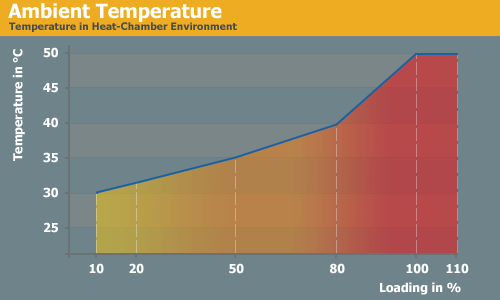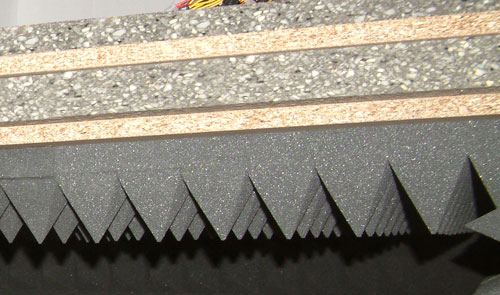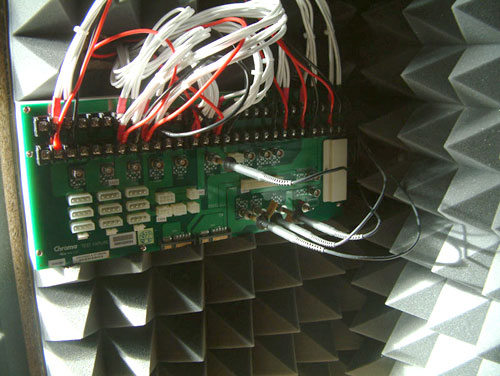Enermax Revolution 85+ High Efficiency PSU
by Christoph Katzer on November 6, 2008 4:15 AM EST- Posted in
- Cases/Cooling/PSUs
Testing with the Chroma ATE Programmable Load

Our test equipment consists of two Chroma programmable DC Loads that enable us to test power supplies with an output of up to 1500W. The biggest advantage of the Chroma DC Loads is simply the high precision it provides. It can measure differences as small as 0.001V and 0.0001A, which will provide us with best-in-class results.
When programming the Chroma with specific amounts of load calculated according to the ATX norm, we are able to load power supplies to an exact percentage. We can now show results at every specific percentage needed. To get the best overview of a power supply, we load each unit with 10%, 20%, 50%, 80%, 100%, and 110% of the specified output. This is easy to calculate for a 1000W power supply: the 10% load is 100W and 110% load is 1100W. Remember that this is the amount of power the PSU delivers; due to inefficiencies, a power supply will actually draw more power from the wall.
Note: If you would like to know more about our testing methodology, equipment, and environment, please read our PSU testing overview.
We have added an additional 10% on the highest load to see how the units perform with overload. This test will be performed in all future reviews. The overload test is performed at room temperature as well as under more stressful conditions; to ensure we are not too cruel to the power supplies, we will keep the ambient temperature at 50°C in the stress test. Experience shows that many units can stand the overload at room temperature but will experience problems with higher temperature and overload together. Only the best-built units will survive this.

The Testing Environment
There is one flaw in testing power supplies with programmable loads while trying to measure the sound pressure levels at the same time. Because the programmable loads get very loud, there is no chance of hearing the power supply on the test stand. In order to make accurate measurements of the noise levels we needed a way to separate the test unit and the programmable loads. Our solution was to build a very thick box around the unit.

We concluded that a five-layer box with a total thickness of 6" (15cm) containing two layers of wood and three layers of special foam would suffice. It is designed as a box within a box. The inner box does not touch any part of the outer box, making it difficult for acoustic noise to pass through in the form of vibration. Each box is isolated on both sides with a layer of heavy foam that is normally used to insulate engines. On the inside we have an additional layer of 4" (10cm) thick pyramidal foam on every side of the box to eliminate the acoustic waves coming from the test object as well as we can.

To ensure a completely closed system we installed the printed circuit board that the connectors of the power supply are attached to inside the anechoic room/box. In other box designs, you would need to put all the cables through the wall. Unfortunately, that would result in the inside of the box not being fully isolated anymore. Our design keeps everything that needs to be connected inside of the box and maintains isolation.










49 Comments
View All Comments
takumsawsherman - Thursday, November 6, 2008 - link
Forgive me for my ignorance, but isn't it the 5V rail that takes care of hard drive power? The reason I ask is that I have a Enermax Whisper 350 that is about 5 years old, and it has 32A on the 5V rail. I can use 4 Hard drives max before the power supply starts to have issues.Does this mean that this power supply could only handle 3? My 3.3 rail is also 30A, and this unit seems to only provide 25. Why so little?
Again, I am looking to be educated, I'm not yet criticizing because I realize that my assumptions are probably incorrect. I've been window shopping for Hard drives for a while now (750GB is not enough any more) and I know i can't add more to my current setup unless I get a better power supply.
Trippytiger - Friday, November 7, 2008 - link
I believe 3.5" hard drives receive power on both the +5V and +12V rails. That the power supplies for external hard drive enclosures provide both voltages suggests this.I'm guessing, given how old your PSU is and how much juice it has on the +5V and +3.3V rails, that its +12V rail is on the weak side and that's the reason it has issues with large numbers of hard drives. It sounds like it was designed to ATX 1.3 specs and was intended for system with a CPU running off of the 5V rail. Since all modern (and not so modern) processors take power from the +12V rail these days, the +5V rail just isn't as critical as it used to be.
You'd probably be much better off with a newer PSU with more power on the +12V rail. Of course, if your system does happen to be ancient... good luck finding something suitable. I went shopping for a PSU for my old AXP+ system several years ago and had a hell of a time finding a unit with a beefy +5V rail back then!
xaris106 - Thursday, November 6, 2008 - link
I`m not sure i understand that "syncronized transformers". But if they work in parallel I am a bit concerned for the approach as variations in the resistance, impendance and coupling factors between the two can lead to unbalanced loading. And it could get worse as components burn in and age.As for the kill a watt measurements I would like to point out that the number is not what the pc components need in power. It includes the psu loses. that means a 300W kill-a-watt measurement means the parts draw 240W (and the psu load) with a 80% efficient psu
JonnyDough - Thursday, November 6, 2008 - link
Try learning words like "kilowatt" and "losses" and then post.xaris106 - Thursday, November 6, 2008 - link
yeah I see why you said that... with "kill-a-watt" i was referring to the wattmeter device that people use in their electric outlets to measure power consumption. I wasn't referring to killowatts...I also misspelled "losses". again sorry for my english.The0ne - Friday, November 7, 2008 - link
You don't need to apologize for your grammar or misspellings on here. People need to understand that there are other members of different race and from different countries to not STUPIDLY assume that they are the only one that matters in the world. If the person is going to make such stupid comments lets see him/her try it on a non-english topic and then report back. Chances are, he/she is probably to lazy in the first place to pick up a second language to even consider trying.That aside, it's the web. Even I don't care about my grammar or spelling here and I write technical reports on a daily basis where I work (to a certain extent of course hahah).
JarredWalton - Friday, November 7, 2008 - link
The power loads in our PSU reviews are *not* measured using a Kill-A-Watt or similar device; see the page on the Chroma testing equipment. When we say there's a 500W load on a PSU and that PSU is 89% efficient at that load, it means the PSU is drawing 562W at the outlet. Our other articles use wall power (because we don't have the equipment elsewhere to measure actual loads).xaris106 - Friday, November 7, 2008 - link
Yes, I know you didn't use a simple wattmeter. Your equipment and test is impressive I would say. I was referring to a comment in page 1 that mentioned a kill-a-watt.As a suggestion, in reviews that you do use outlet power, it would be nice to make a note of it and that the numbers include power losses (and even the approximate efficiency if you use a tested psu) so people can have it in mind.
Now just an idea.Wouldn't it be nice for you to make a set of connectors that plug between the psu connectors and the motherboard/devices that can go through ampmeters? So we can see all those dc currents. Although that might me a lot of ampmeters...and a bit risky. Just a thought.
My regards.
The0ne - Friday, November 7, 2008 - link
I don't see why you can't hook up a current probe connected to a O-scope to measure the current.JarredWalton - Friday, November 7, 2008 - link
Christoph did something like that in his http://www.anandtech.com/casecoolingpsus/showdoc.a...">Power Supply Myths article... not really something to do in every review if we can avoid; they take long enough already! ;)